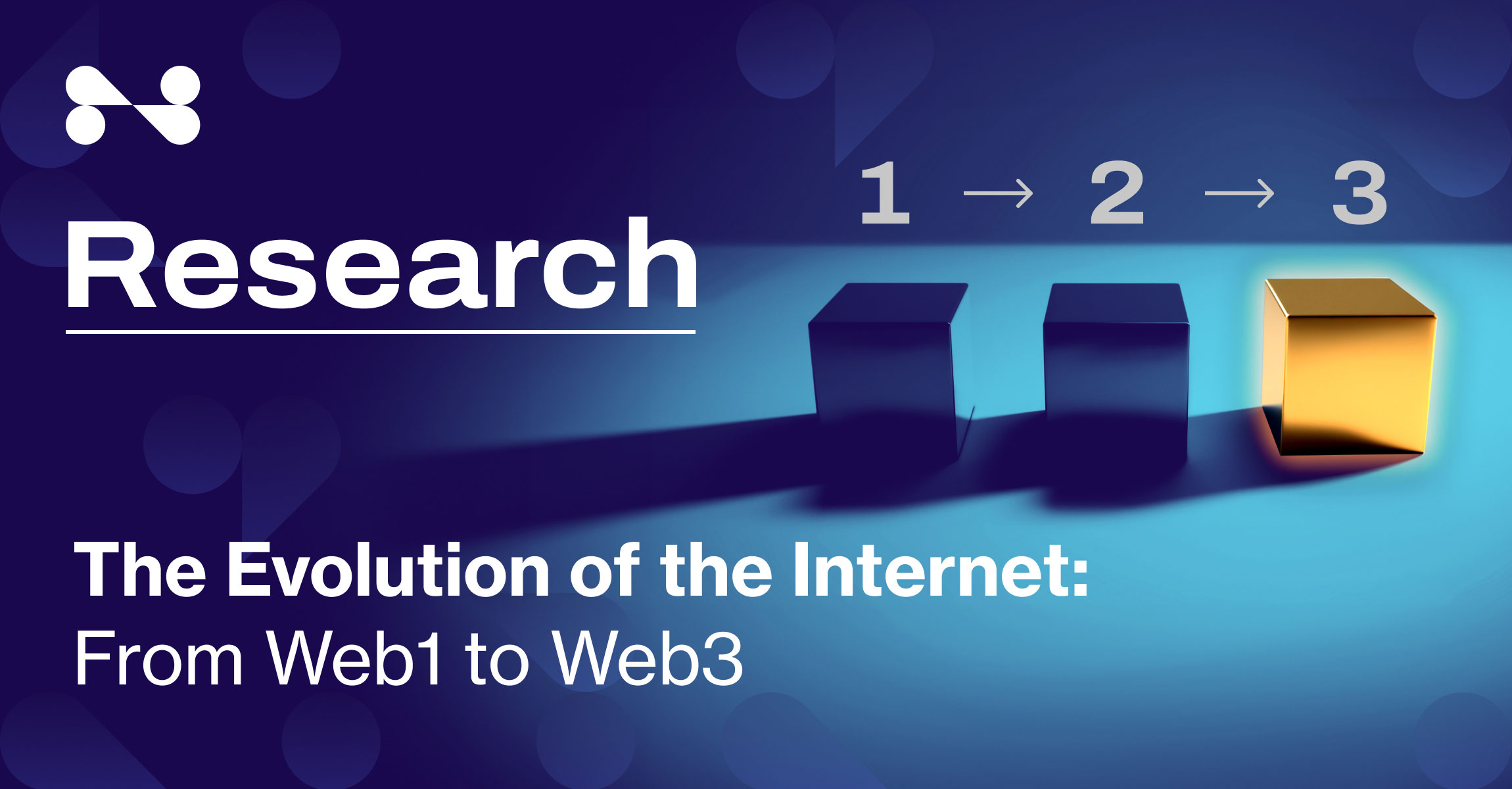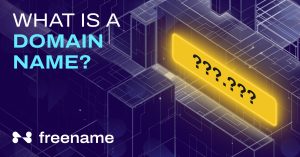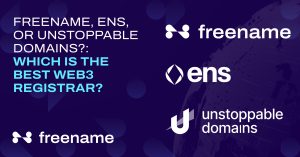If you’re curious about how Web3 is emerging as the new frontier of the internet and wonder about its origins, it’s essential to explore the evolution of the Web.
Let’s take a closer look at the Internet’s history, starting from its early days, through the changes brought by Web1 and Web2, and leading up to the current era of Web3. We’ll see how this latest development represents a crucial moment in how the Internet evolves, introducing new domains and top-level domains (TLDs), and setting the stage for a new way of online interaction.
By placing Web3 within the broader context of the Web’s evolution, we can understand its groundbreaking potential and how it’s poised to reshape not only the Internet but also our society at large.
Web1: The First Steps into the Digital World
Imagine a time when the digital landscape was just a barren expanse, waiting for its first pioneers. This is the tale of Web1, a narrative of innovation and visionary ambition that traces back to 1989. In that year, Sir Tim Berners-Lee, an English physicist working at CERN, had an idea that would change the world. He imagined a global hypertext system that would allow researchers to share and access information regardless of their physical location or the computer they were using. This concept was the seed that grew into the World Wide Web as we know it today.
Berners-Lee’s invention was driven by a simple yet powerful goal: to facilitate the sharing and discovery of knowledge on a global scale. The outcome of his work, however, transcended his initial vision. Web1 didn’t just connect researchers; it laid the foundation for the vast digital infrastructure that has become integral to our daily lives.
In the early days of Web1, the internet was a collection of static HTML pages. These websites allowed people to find and read information, but interaction was minimal. Users were mostly onlookers, consuming content without contributing to it. Despite its limitations, this version of the web was revolutionary, setting the stage for a new era of information exchange and communication.
To grasp the scale of this revolution, let’s look at the numbers. In 1991, the internet was home to barely a handful of sites. Fast forward to 1995, and there were 23,500 websites. By the end of 1999, this number had exploded to over 3 million.

Alongside this growth in websites, the number of internet users surged from a few researchers to over 280 million people worldwide, or about 3.5% of the global population at the time.

This exponential growth marked the dawn of the digital age, leading to the development of Web2 and paving the way for Web3. Although Web1’s capabilities might seem limited by today’s standards, its impact on society and the way we access information is monumental. It was the first step towards a world where knowledge and communication are boundless, connecting people across the globe in ways previously unimaginable.
For further insights into the evolution of the web and its stages, The World Wide Web Consortium (W3C), founded by Tim Berners-Lee, provides a lot of information and resources that trace the web’s history and outline its future potential.
The First Domain Registration: A Groundbreaking Moment
Turn back the clock to the early days of the internet, a period when the online world was just beginning to take shape. One of the most notable milestones during this time was the registration of the first-ever domain name: “Symbolics.com.” This event occurred on March 15, 1985, when Symbolics, a company specializing in computer systems, claimed this domain. This act laid the foundation for the domain registration system that is integral to navigating the internet today.
The registration of “Symbolics.com” was a significant leap forward in organizing the internet, introducing a structured way to identify and access websites. At first, domain registrations were few and far between, reflecting the internet’s limited reach and the novelty of connecting online. Within the first year after “Symbolics.com” was registered, fewer than ten domains were claimed. This slow start was emblematic of the internet’s nascent stage, where its potential was only just beginning to be realized.

By 1987, there were 100 domains registered, indicating a growing recognition of the internet’s value for business and communication. This momentum continued, and by 1990, the number of registered domains exceeded 1,000. Each registration marked a point of growth for the internet, contributing to the vast network of resources and connections we depend on today. (click here to learn how to check a domain history)
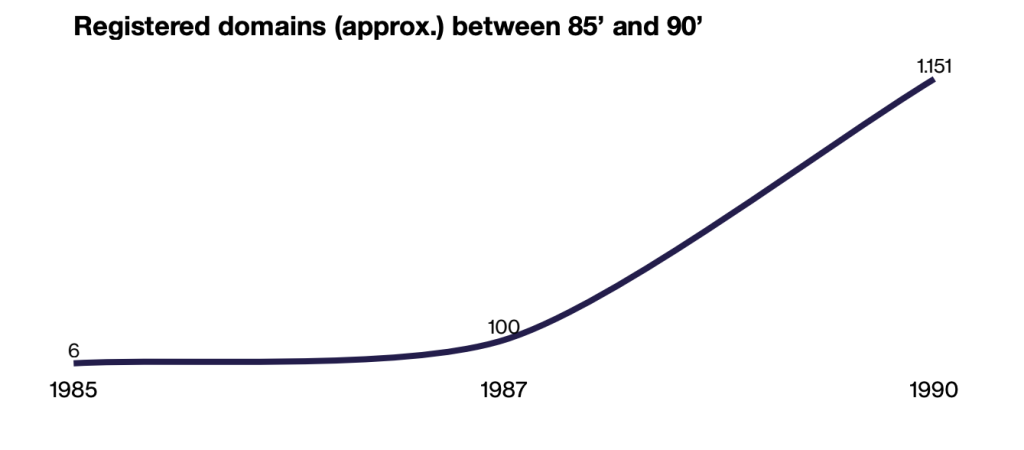
The early days of domain registration highlight a pivotal shift in how we interact with information and each other. From a handful of domains to millions today, this evolution mirrors the exponential growth of the internet itself.
The Birth of ICANN: Organizing the Internet’s Framework
Before the creation of ICANN, the responsibility of overseeing domain names and IP addresses fell on a few key organizations, including the Network Information Center (NIC) operated initially by the Stanford Research Institute (SRI) and later by entities like InterNIC. As the internet began to grow, these organizations found themselves overwhelmed by the increasing demand and complexity of managing the expanding domain system. The situation was further complicated by a lack of coherent strategy and a unified mandate, making it difficult to adapt to the rapid changes and needs of the internet’s infrastructure.
Amidst the rapid expansion of the early internet, concerns about the NIC’s capacity to manage its responsibilities effectively reached a tipping point. It became clear that a new framework was needed to oversee the domain name system and ensure its orderly evolution. This led to a landmark development in 1998: the formation of the Internet Corporation for Assigned Names and Numbers (ICANN), established with the support of the U.S. government. ICANN’s creation was a response to the urgent need for an organization that could bring structure, clarity, and transparency to the internet’s domain name system.
ICANN was tasked with several critical functions, including allocating IP address spaces, accrediting domain name registrars, and managing the system of top-level domains (TLDs). This shift towards a more organized and standardized approach to internet governance sparked a dramatic increase in the number of domain registrars. In the early years of ICANN’s operation, the number of accredited registrars grew from just a few to hundreds, contributing to a surge in the domain industry. By the end of 2000, there were nearly 100 registrars accredited to offer .com, .net, and .org domains, signifying a new era of accessibility and diversity in the domain registration landscape.
The establishment of ICANN represented an important moment in the internet’s history, laying the groundwork for a more structured and efficient management of the internet’s core elements. This development not only facilitated the internet’s continued expansion but also ensured its stability and accessibility for the millions of users and entities that rely on it today.
From 50,000 to Millions: The Domain Race in the ’90s
The 1990s marked an era of exponential growth for the internet, transforming it from a tool primarily used by academics and tech enthusiasts to a global platform integral to commerce and communication. This transformation was notably reflected in the surge of domain name registrations, a clear indicator of the internet’s burgeoning commercial and social appeal.
In the early part of the decade, domain registrations were a modest affair, with numbers just beginning to climb. However, as the internet’s potential began to unfold and more businesses and individuals recognized the value of having an online presence, these numbers started to skyrocket. By 1995, the number of registered domains had already exceeded 50,000, a milestone that underscored the internet’s move towards mainstream adoption.
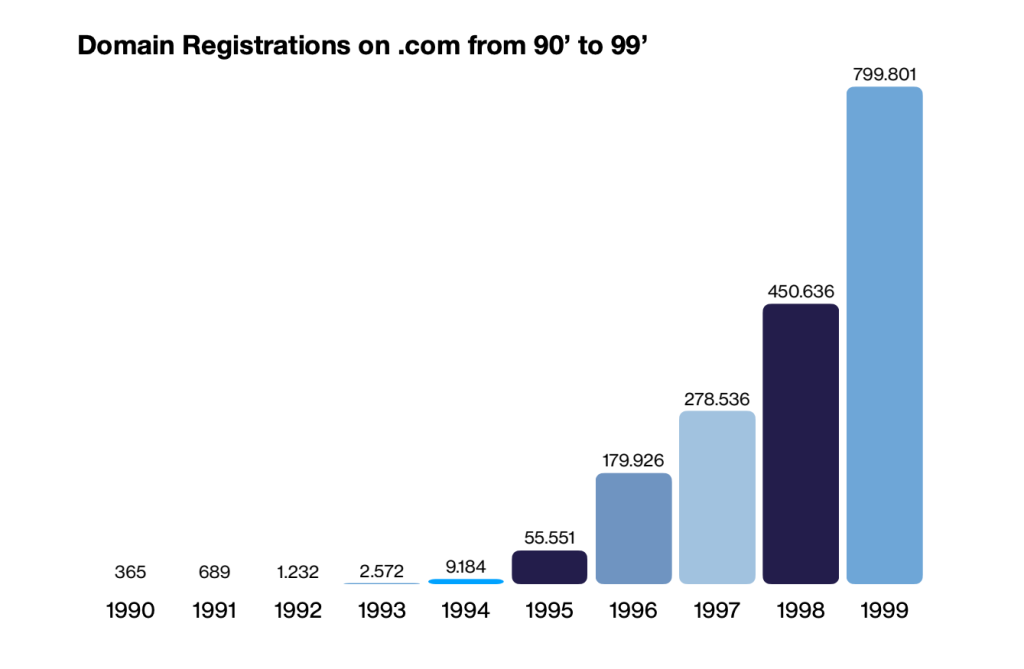
This upward trajectory continued unabated through the second half of the decade. Advances in technology, along with the increasing accessibility of internet services, fueled a domain registration frenzy. By the dawn of the new millennium, the total count of registered domains had soared to over 1.5 million. This remarkable growth wasn’t just about the numbers; it reflected a paradigm shift in how society perceived and utilized the internet. It was no longer a niche or emerging technology but had become a critical component of the global infrastructure, indispensable for business operations, information dissemination, and social interactions.
The swell in domain registrations during the ’90s was more than a trend; it was a signal that the internet had grown up. It was becoming the vast, interconnected world we know today, where having a digital presence is nearly as fundamental as having a physical one. This period also shown the need for more nuanced and effective management of the internet’s growing real estate, something that organizations like ICANN have been striving to address.
Web2: The Era of Interaction and Collaboration
When Web2 rolled around, it was like someone had flipped a switch on the internet. Gone were the days when browsing the web was akin to flipping through a static catalog. In the early 2000s, Tim O’Reilly and the team at O’Reilly Media brought the term “Web 2.0” into the spotlight during their Web 2.0 Conference in 2004. This wasn’t just a new chapter; it was almost like a whole new book.
Web2 answered the call for more interaction and participation on the web. Suddenly, everyone with access to the internet didn’t just consume content; they could create it, comment on it, and share it with a simple click. Blogs became as common as morning coffee, social networks connected people across continents, and video-sharing platforms made everyone a potential filmmaker.
This change was monumental. Think about it: in 1999, there were around 3 million websites. Fast forward to 2005, and that number had ballooned to over 64 million. This wasn’t just about numbers, though. It was about the doors it opened. As the web grew, so did its user base—from 280 million in 1999 to over a billion by 2005. By 2015, this number had quadrupled.
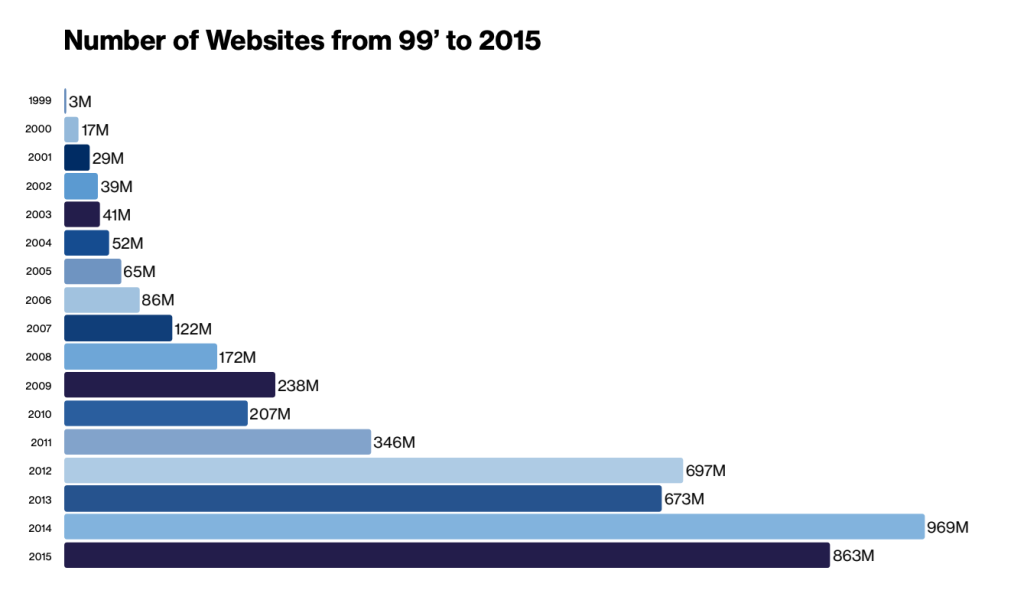
The real game-changers of Web2 were platforms like Facebook, which stepped onto the scene in 2004, YouTube in 2005, Twitter in 2006, and Instagram in 2010. These platforms did more than just allow people to share photos or thoughts; they redefined how we communicate, learn, and even perceive the world around us.
In essence, Web2 transformed the internet from a library into a living, breathing workshop where anyone could contribute, collaborate, and share. This wasn’t just a technical upgrade; it was a cultural revolution that set the stage for the even more immersive and interactive Web3.
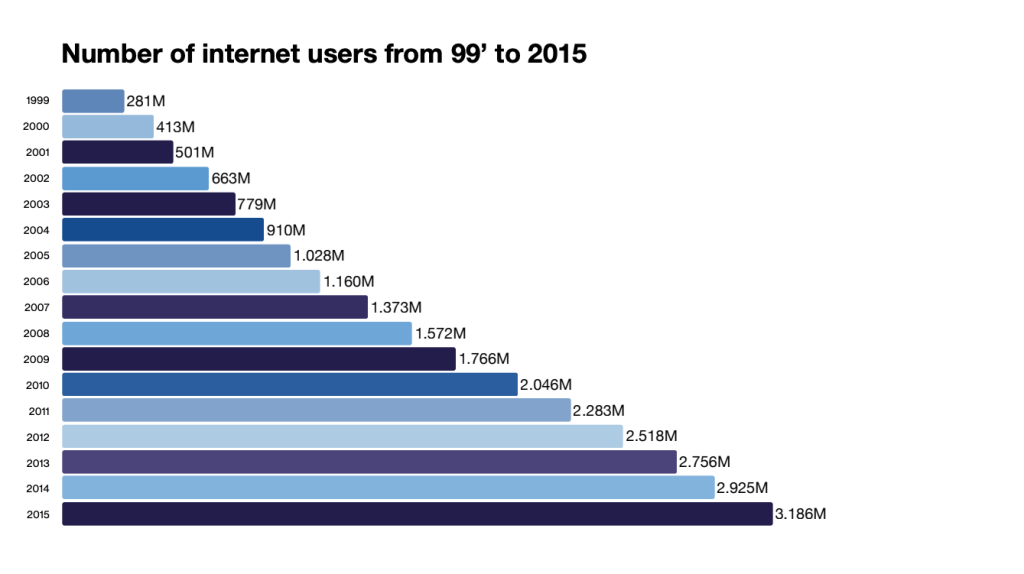
For a deeper understanding of Web2 and its impact, the Internet Society offers extensive resources and analysis. They provide a broad overview of internet history, including the pivotal shifts that have shaped the way we interact with digital technology today.
The Rise of an Internet Titan: .Com
Since its first appearance in 1985, the .com top-level domain (TLD) has been a remarkable story of success. More than just a part of the web’s infrastructure, .com has emerged as a symbol of the internet’s expansive potential, guiding countless entrepreneurs, innovators, and creators along their digital journeys.
Through the years, .com has grown into an unmistakable giant in the online world. Its influence stretches across millions of websites, making it a cornerstone of internet identity. Like a lighthouse guiding ships through the night, .com has become a beacon for those looking to make their mark online, offering a platform for visibility, credibility, and opportunity.
The year 2022 stood as a stunning moment for .com, as it saw the domain count soar to over 200 million registrations. This isn’t just a number; it’s a testament to the enduring appeal and trust that .com commands. Capturing more than 30% of all domain registrations worldwide, this milestone underscores the unparalleled position of .com in the digital realm.
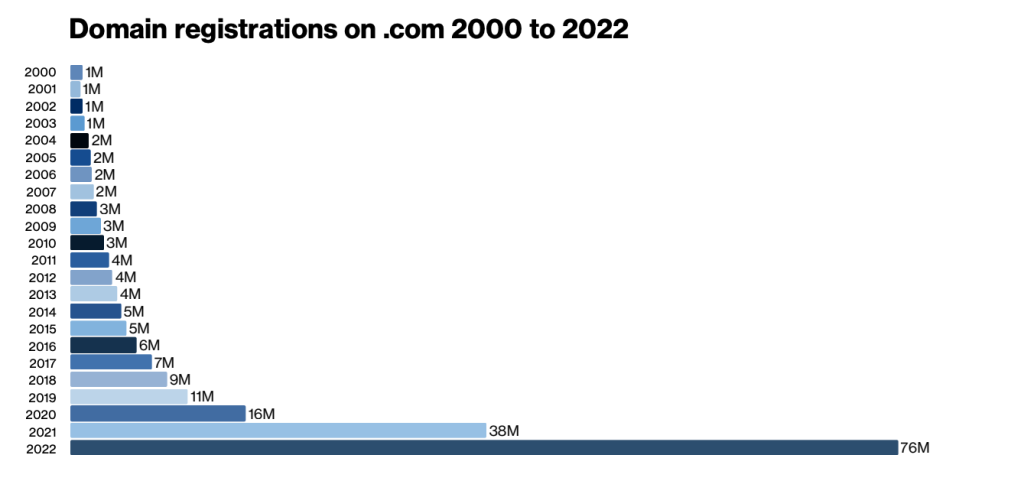
The significance of .com extends beyond its vast adoption. It represents the internet’s history, growth, and the dreams of millions who venture online. The name itself has become a byword for trust and presence on the internet, serving as a pivotal reference point for navigating the boundless possibilities of the online world.
The journey of .com mirrors the internet’s own evolution—from a niche network of academics and researchers to a global platform that touches every aspect of our lives. Its widespread recognition and reliability make .com not just a domain, but a symbol of the internet’s power to connect, empower, and inspire across generations and geographies.
The Creative Solution to a Crowded .Com World
As the digital gold rush for .com domains left fewer treasures to be found, the internet community faced a dilemma. The quest for distinctive, memorable domain names in a sea of millions became tougher by the day. This challenge didn’t go unanswered. The introduction of over 1,600 new top-level domains (TLDs) has been like opening new lands for exploration, providing a much-needed release valve for the pressure of finding the perfect .com address.
These new domains have transformed the naming game on the internet, offering a breadth of choices that could hardly have been imagined in the early days of the .com dominance. More than just alternatives, these new TLDs—over 15 of which have already captured more than 1% of total domain registrations—represent the diversification of the internet’s naming system itself.
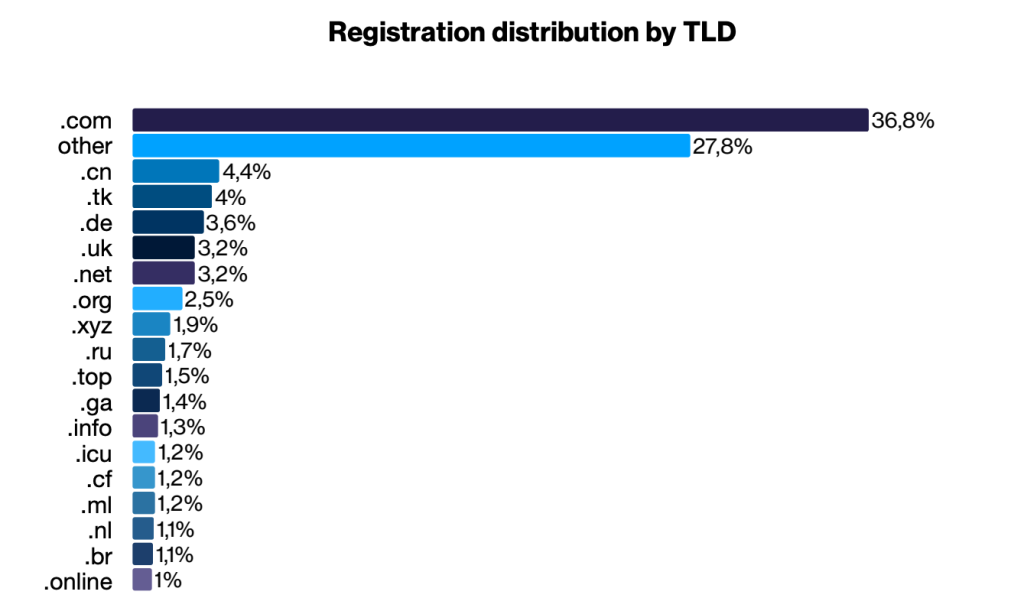
From industry-specific (.tech, .art, .fashion) to location-based (.nyc, .paris, .berlin) and beyond, the variety of available extensions means that your domain name can say so much more about who you are and what you do. It’s a shift from the scramble for .com availability to a more thoughtful consideration of how a name can reflect an entity’s essence online.
This shift towards new TLDs marks a significant moment in the internet’s history. It’s about more than just providing additional options; it’s about enriching the internet with a diversity of voices and perspectives, making it easier for everyone to find a domain name that truly resonates with their personal or business identity.
The Challenge to Traditional Domains
As the web has grown and evolved, what used to be seen as its bedrock—the domain name system—has started to reveal some deep-seated issues. Centralization, a hotly debated topic when discussing the future of the internet, has found a particularly strong foothold within the traditional domain name ecosystem.
Recent findings have shown that over 20% of all domain names worldwide are controlled by just a handful of major domain registries. This concentration of power has sparked widespread concern over issues like censorship, a lack of openness, and the potential for misuse of authority. Moreover, the cost of renewing domain names has been on an upward trend, increasing by at least 7% in the last year alone, and by more than 30% since 2011. These rising costs hint at the consequences of such a centralized approach.
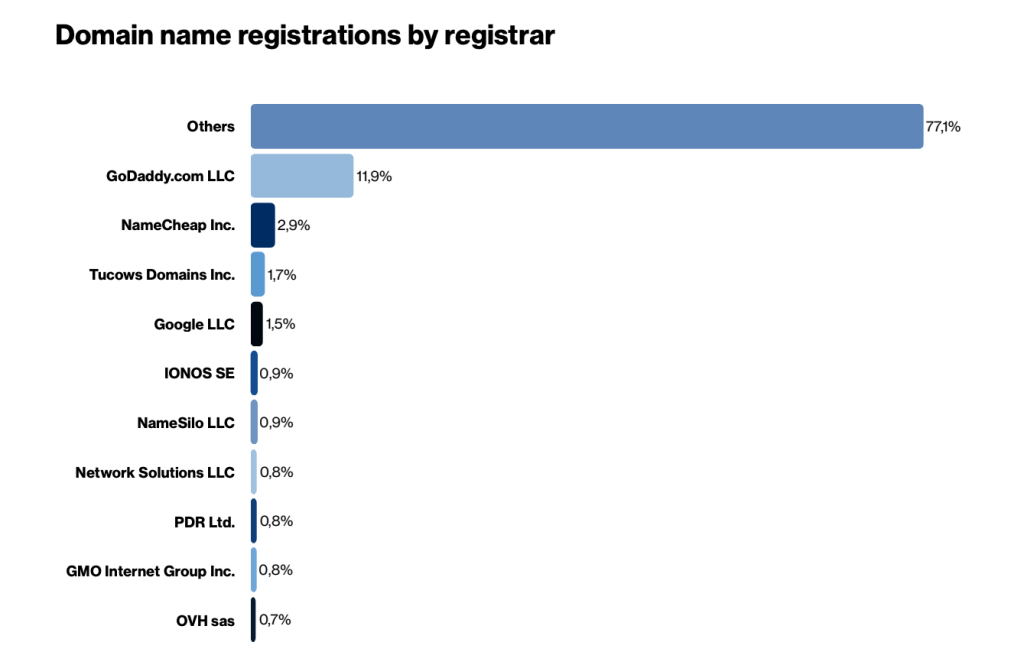
On the flip side, Web3 promises a landscape reshaped by decentralization, challenging the status quo of how the internet is structured. This vision for the future web, where control and ownership are spread across its users rather than held by a few gatekeepers, is becoming increasingly appealing. The push towards decentralized platforms and domains is gaining momentum, driven by the desire for more democratic and transparent online spaces.
This growing preference for decentralization is not just a trend; it’s a response to the limitations and frustrations many have experienced with the traditional domain system. As Web3’s promise of a more open and user-empowered internet draws nearer, it signals a potential shift away from centralized control. This movement toward a new paradigm of digital independence could redefine our understanding of online presence and identity, marking a significant turning point in the history of the internet.
Welcome to Web3: A New Chapter for Internet Freedom
Back in 2013, the seeds of a radically different internet were sown, giving birth to the concept of Web3. This wasn’t just another update; it was a whole new vision for the internet, one that championed decentralization right down to its core, including how we think about domain names and their top-level domains (TLDs).
The shift towards Web3 has been fueled by two major concerns. First, there’s an increasing demand for privacy and security online. People are more aware and cautious about who controls their personal information and how it’s used. The second driver is the potential of blockchain technology. Known for its robust security, transparency, and resistance to censorship, blockchain offers a solid foundation for a new internet era and work with data tokenization at its best.
Web3 domains and TLDs are at the forefront of this transformation and they represent a significant leap towards a more secure, private, and user-controlled internet. Imagine a world where your online identity and assets are truly yours, shielded from unwanted surveillance and censorship.
This vision of Web3 involves a shift towards an internet that empowers its users, handing back control to where it belongs: with the people. It’s an exciting time to be online, as we stand on the cusp of an era that promises to redefine our digital interactions and freedoms.
The Web3 Investment Surge: Billions Flow into the Future of the Internet
The year 2022 turned out to be a watershed moment for Web3, the next phase of the internet’s evolution, marked by an explosion in investment. The numbers are staggering: a whopping $7.1 billion poured into Web3 startups, showcasing the immense faith and interest investors have in the potential of a decentralized web.
The Web3 gaming sector emerged as the biggest magnet for this investment, drawing in $4.49 billion. This shouldn’t come as a surprise, given gaming’s role as a pioneer in adopting and integrating Web3 technologies, from blockchain to virtual economies. Following closely, the metaverse—a concept that has captured the imagination of tech enthusiasts and skeptics alike—garnered $1.8 billion, reflecting its growing importance as a space for innovation. Social networks, though trailing, still managed to attract a significant $259.1 million, hinting at the evolving ways we connect and interact online.
This influx of investment, up by $4.8 billion from the previous year, shows a rapidly growing enthusiasm for what the Web3 space promises: a more open, user-owned internet. Leading the charge in fueling these groundbreaking projects was Paradigm, a venture capital firm that alone invested $2.5 billion across 31 ventures. Close on its heels were industry heavyweights like Andreessen Horowitz, Sequoia China, and Matrix Partners China, each making substantial bets on the future of Web3.
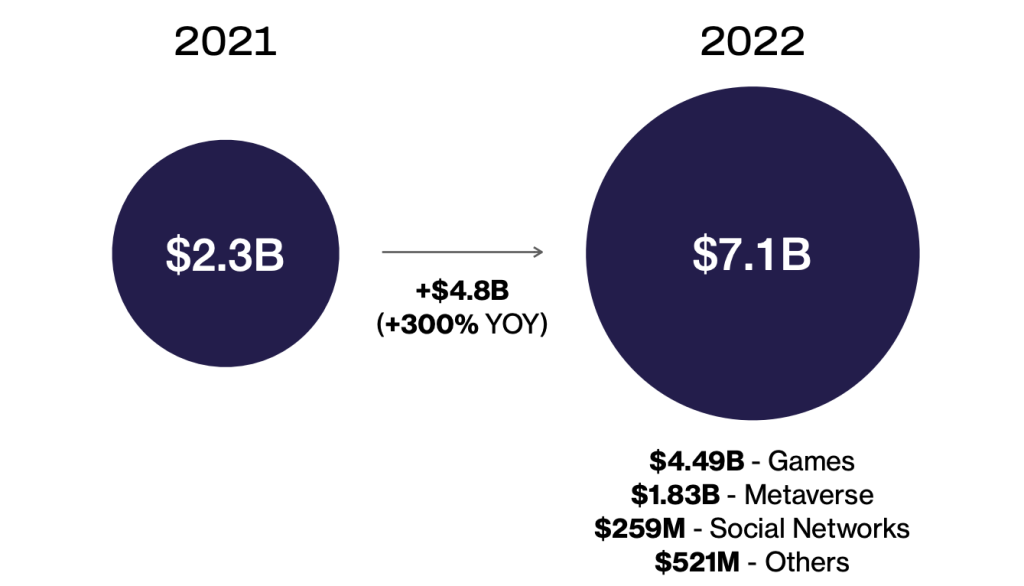
This surge in investment signals a clear message: the Web3 sector is not just simmering; it’s boiling over with potential. As more capital flows into developing decentralized applications and services, we stand on the brink of a major shift in how we interact with digital technologies. The commitment from some of the tech world’s most influential investors reflects a confidence that Web3 could redefine our digital experiences, making them more immersive, interactive, and—most importantly—user-centric.
A Decade of Transformation: 2023 to 2033
In 2023, the Web3 Blockchain sector was already making waves, boasting a market value of $4.6 billion. Yet, this is just the tip of the iceberg. Fast forward to 2033, and we’re looking at a projected market explosion to anticipated to be reaching $177.58 billion thanks to a robust Compound Annual Growth Rate (CAGR) of 44.1% during the forecast period from 2024 to 2033.
$116.51 billion, thanks to a robust annual growth rate of 44.9%. This isn’t just growth; it’s a revolution.
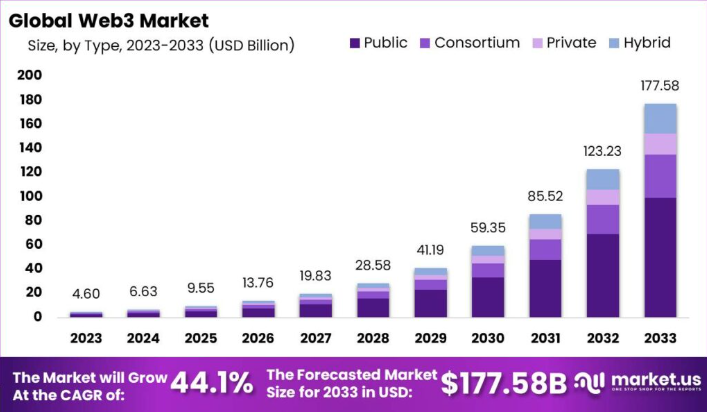
Why such a meteoric rise? It’s not happenstance but the result of a confluence of transformative trends and technological leaps:
- Decentralization and Privacy: Today, guarding our digital selves has never been more crucial. Web3 steps in with a game-changing offer: decentralized identity. This innovation hands back control to users, ensuring our data stays secure and sovereign.
- The Next Wave of Connectivity: The roll-out of 5G and the upcoming 6G networks are setting the stage for Web3 to unleash its full potential. High-speed, low-latency networks mean Web3 technologies can operate at unprecedented efficiency and scale.
- Cryptocurrency Gains Ground: Cryptocurrencies, the lifeblood of the Web3 economy, are climbing in importance and value. This rise is not just enhancing blockchain’s credibility but also propelling its adoption across sectors.
- An Expanding IoT Universe: Our world is increasingly populated with smart, internet-connected devices. This proliferation extends the reach of Web3, embedding it more deeply into our daily lives and interactions.
- Revolutionizing Transactions: At its core, Web3 promises transactions that are not just faster but more transparent and secure. This overhaul of how we exchange goods, services, and value is making the digital space more trustworthy.
Looking at these driving forces, the prediction for Web3 Blockchain’s growth by 2033 seems not just hopeful but an inevitable step into a future where digital efficiency, security, and user autonomy reign supreme. This decade could well mark the era when Web3 transforms from a promising technology into the backbone of a new digital epoch.
Rediscovering Freedom in Our Online Lives
Remember the early days of the internet? It felt like a wide-open frontier, ripe for exploration and filled with possibilities. Fast forward, and it seems like a few big names got too much say in how things run. That’s what’s sparked a whole movement towards something different: Web3.
Here’s the deal: the way things have been going, with a few giants holding all the cards, hasn’t been great for everyone. Issues like censorship, privacy nightmares, and rising costs are real headaches. That’s where Web3 comes in, swinging the door wide open to a world where no single player can control the game.
Web3 is all about taking the tech that makes cryptocurrencies tick—blockchain—and using it to run everything online. This means money can move around without going through a bank, messages can stay private, and websites can exist without the risk of getting shut down for saying the wrong thing.
But here’s the kicker: moving to Web3 isn’t just about getting new gadgets or apps. It’s a whole new way of thinking about the internet. Instead of treating it like a mall where a few big companies set up shop, Web3 sees it more like a public park. It’s ours, not theirs. This shift is about making sure that when we log on, we’re stepping into a place that’s open, fair, and where everyone has a say.
This isn’t just tech talk. It’s about getting back to what the internet was supposed to be—a place where anyone can share ideas, start something new, and have a fair shot without being overshadowed by the big guys. Web3 is our chance to take the internet’s steering wheel and drive it back to its original destination: freedom, creativity, and a spot for everyone at the table.
From Static Pages to a Decentralized Future: The Evolution from Web1 to Web3
The internet is like a living, breathing entity, constantly evolving and reshaping itself. Its journey from the static, one-way streets of Web1, through the bustling highways of Web2’s interaction and collaboration, to the sprawling, open landscapes of Web3’s decentralization, mirrors our own evolution in how we interact with digital content and each other.
Web1 gave us the internet as a digital library—a collection of static pages where information was to be consumed rather than interacted with.
Then came Web2, flipping the script and turning us all into creators, collaborators, and communicators, weaving social networks and content creation into the fabric of daily life.
Now, we’re on the cusp of Web3, which promises a world where digital sovereignty is real, where our online spaces are ours to own, and where our data is protected by the very architecture of the web itself.
As we look back on the path from Web1 through Web2, and gaze ahead at the horizon Web3 offers, it’s clear we’re not just witnessing a technological evolution, but a cultural revolution. The question of “What’s next?” is as exciting as it is vast, and the possibilities are as limitless as our collective imagination.
For those ready to dive into building this new phase of the internet, Freename offers a gateway to acquiring Web3 domains. It’s not just about claiming a corner of the internet anymore; it’s about shaping what the future of the web will look like. Whether you’re a creator, innovator, or dreamer, the time is now to start building on the decentralized web and stake your claim in the next chapter of our digital story.
References:
- Internet Live Stats – Total number of websites
- Wikipedia – The oldest registered domain names
- Iaps – List of .com domains
- ICANN – ICANN Accredits Ten New Domain Name Registrars
- Wipo – Total number of domain names by year
- Blockzeit – Web3 startups raise over $7 billion in 2022
- Market.us – Global Web3 market size

